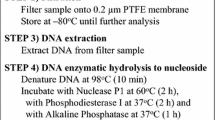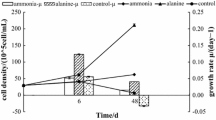Abstract
In aquatic ecosystems, [3H]thymidine incorporation into bacterial DNA and [3H]leucine incorporation into proteins are usually used to estimate bacterial production. The incorporation rates of four amino acids (leucine, tyrosine, lysine, alanine) into proteins of bacteria were measured in parallel on natural freshwater samples from the basin of the river Meuse (Belgium). Comparison of the incorporation into proteins and into the total macromolecular fraction showed that these different amino acids were incorporated at more than 90% into proteins. From incorporation measurements at four subsaturated concentrations (range, 2–77 nm), the maximum incorporation rates were determined. Strong correlations (r > 0.91 for all the calculated correlations) were found between the maximum incorporation rates of the different tested amino acids over a range of two orders of magnitude of bacterial activity. Bacterial production estimates were calculated using theoretical and experimental conversion factors. The productions calculated from the incorporation rates of the four amino acids were in good concordance, especially when the experimental conversion factors were used (slope range, 0.91–1.11, and r > 0.91). This study suggests that the incorporation of various amino acids into proteins can be used to estimate bacterial production.
Similar content being viewed by others
References
Azam F, Fuhrman JA (1984) Measurement of bacterioplankton growth in the sea and its regulation by environmental conditions. In: Hobbie JE, Le PJ, Williams B (eds), Heterotrophic activity in the sea. Prenum Press, New York
Bell RT, Ahlgren G, Ahlgren I (1983) Estimating bacterioplankton production by measuring (3H)-thymidine incorporation in an eutrophic Swedish lake. Appl Environm Microbiol 45:1709–1721
Böjrnsen PK, Kuparinen J (1991) Determination of bacterioplankton biomass, net production and growth efficiency in the Southern Ocean. Mar Ecol Progr Ser 71:185–194
Chin-Leo G, Kirchman D (1990) Unbalanced growth in natural assemblages of marine bacterioplankton. Mar Ecol Progr Ser 63:1–8
Cole JJ, Findlay S, Pace ML (1988) Bacterial production in fresh and saltwater ecosystems: a cross system overview. Mar Ecol Progr Ser 43:1–10
Ducklow HW, Carlson CA (1992) Oceanic bacterial production. Adv Microb Ecol 12:113–181
Fuhrman JA, Azam F (1980) Bacterioplankton secondary production estimates for coastal waters of British Columbia Antarctica and California. Appl Environ Microbiol 39:1085–1095
Fuhrman JA, Azam F (1982) Thymidine incorporation area measure of heterotrophic bacterioplankton evaluation in marine surface waters: evaluation and field result. Mar Biol 66:109–120
Jorgensen N OG (1982) Heterotrophic assimilation and occurrence of dissolved free amino acids in a shallow estuary. Mar Ecol Progr Ser 8:145–159
Jorgensen NOG (1987) Free amino acids in lakes: concentrations and assimilation rates in relation to phytoplankton and bacterial production. Limnol Oceanogr 32:97–111
Jorgensen NOG (1992) Incorporation of (3H)-leucine and (3H)-valine into protein of freshwater bacteria: field application. Appl Environ Microbiol 58:3647–3653
Jorgensen NOG (1992) Incorporation of (3H)-leucine and (3H)-valine into protein of freshwater bacteria: uptake kinetics and intracellular isotope dilution. Appl Environ Microbiol 58:3638–3646
Kirchman D, K'Nees F, Hodson R (1985) Leucine incorporation and its potential as a measure of protein synthesis by bacteria in natural aquatic systems. Appl Environ Microbiol 49:599–607
Kirchman D, Newell SY, Hodson RE (1986) Incorporation versus biosynthesis of leucine: implications for measuring rates of protein synthesis and biomass production by bacteria in marine systems. Mar Ecol Prog Ser 32:47–59
Kirchman DL, Hoch MP (1988) Bacterial production in the Delaware estuary estimated from thymidine and leucine incorporation rate. Mar Ecol Prog Ser 45:169–178
Kirchman DL (1992) Incorporation of thymidine and leucine in the subarctic Pacific: application to estimating bacterial production. Mar Ecol Prog Ser 82:301–309
Lavandier P, Fauré F, Kaviani F (1991) Estimation de la production du bactérioplankton hétéro-trophe d'eau douce à partir des taux d'incorporation de thymidine et de leucine tritiée. In: Vernet JP (ed): “Hommage à F.A. Forel” C.R. 3ème conf Intern Limnol d'Expr Franç, pp. 88–91
Porter KG, Feig YS (1980) Use of DAPI for identifying and counting aquatic microflora. Limnol Oceanogr 25:943–948
Reeck GR (1983) Amino acid composition of selected proteins. In: Laskin AI, Lechevalier HA (eds) Microbial composition (Handbook of microbiology, vol 2). Boca Raton, Fla., CRC Press, pp. 15–25
Riemann B, Bjömsen PK, Newell S, Fallon R (1987) Calculation of cell production of coastal marine bacteria based on measured incorporation of 3H-thymidine. Limnol Oceanogr 32:471–476
Riemann B, Bell RT (1990) Advances in estimating bacterial biomass and growth in aquatic systems. Arch Hydrobiol 118:385–402
Riemann B, Azam F (1992) Measurements of bacterial protein synthesis in aquatic environments by means of leucine incorporation. Marine Microbiol Food Webs 6:91–105
Servais P (1989) Bacterioplankton biomass and production in the river Meuse (Belgium). Hydrobiologia 174:99–110
Servais P (1990) Estimation de la production bactérienne en milieu marin par mesure du taux de synthèse protéique. Oceanologica Acta 13:229–235
Servais P (1992) Bacterial production measured by (3H)-thymidine and (3H)-leucine incorporation in various aquatic ecosystems. Archiv Hydrobiol Ergebn Limnol 37:73–81
Servais P, Gamier J (1993) Contribution of heterotrophic bacterial production to the carbon budget of the river Seine (France). Microbioal Ecology 25:19–33
Servais P, Lavandier P (1993) Coherence des productions bactériennes estimées à partir de Fincorporation de 3H-thymidine et de (3H)-leucine dans les eaux douces naturelles. Compte-Rendu de l'Académie des Sciences 316:642–646
Simon M, Azam F (1989) Protein content and protein synthesis rates of planktonic marine bacteria. Mar Ecol Progr Ser 51:201–213
Simon M (1991) Isotope dilution of intracellular amino acids as a tracer of carbon and nitrogen sources of marine planktonic bacteria. Mar Ecol Progr Ser 74:295–301
Simon M, Rosenstock B (1992) Carbon and nitrogen sources of planktonic bacteria in lake Constance studied by the composition and isotope dilution of intracellular amino acids. Limnol Oceanogr 37:1496–1511
van Looij A, Riemann B (1993) Measurements of bacterial production in coastal marine environments Using leucine: application of a kinetic approach to correct for isotope dilution. Mar Ecol Progr Ser 102:97–104
Author information
Authors and Affiliations
Rights and permissions
About this article
Cite this article
Servais, P. Measurement of the incorporation rates of four amino acids into proteins for estimating bacterial production. Microb Ecol 29, 115–128 (1995). https://doi.org/10.1007/BF00167159
Received:
Revised:
Issue Date:
DOI: https://doi.org/10.1007/BF00167159




